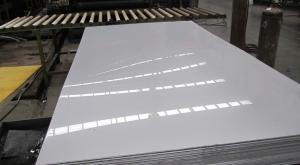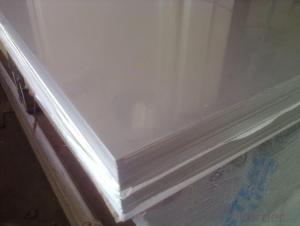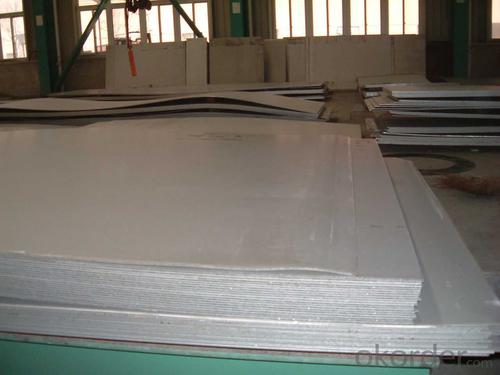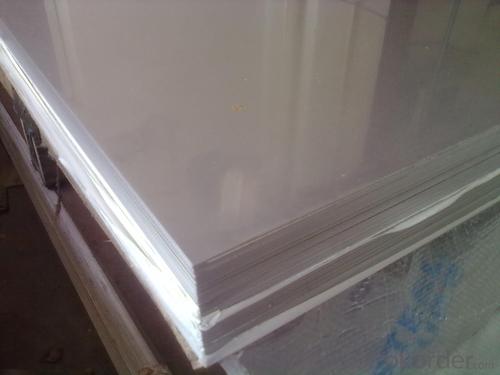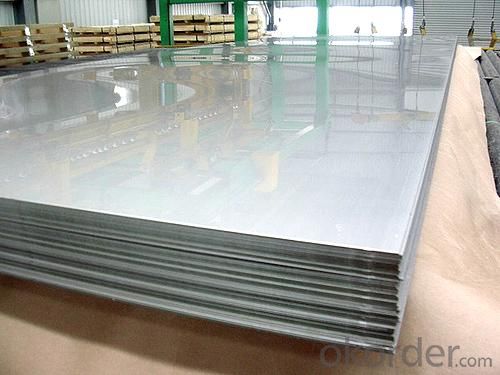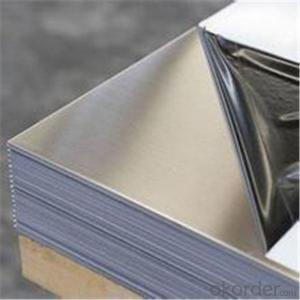Stainless Steel Sheet with 3mm Thickness
- Loading Port:
- Shanghai
- Payment Terms:
- TT or LC
- Min Order Qty:
- 2000 m.t
- Supply Capability:
- 5000000 m.t/month
OKorder Service Pledge
OKorder Financial Service
You Might Also Like
Stainless Steel Sheet with 3mm Thickness
Description of Stainless Steel Sheet with 3mm Thickness:
Stainless steel is a production which not easy rust,acid resistance and corrosion resistance,so it is widelyused in light industry,heavy industry,daily necessities and the decoration industry.my company long-termsupply stainless steel porducts including:stainless steel sheet,stainless steel coil and stainless steel tube.
Main Features of Stainless Steel Sheet with 3mm Thickness:
•Escalator, Elevator, Doors
•Furniture
•Production tools, Kitchen appliances, freezers, cold rooms
•Auto Parts
•Machinery and Packaging
•Equipment and Medical devices
•Transport system
Maintance of Stainless Steel Sheet with 3mm Thickness:
(1) Regular cleaning and maintenance
(2) Pay attention to prevent the occurrence of the phenomenon of surface scratches
(3) Use soap, weak detergent or warm water to remove surface dust, dirt
(4) In addition to the surface of the binder with alcohol or an organic solvent (ether, benzene)
(5) Use neutral detergent or ammonia solution in addition to surface oil
(6) With 10% nitric acid or abrasive detergent in addition to the surface of the embroider caused by the dirt.
Applications of Stainless Steel Sheet with 3mm Thickness:
Stainless steel’s resistance to corrosion and staining, low maintenance and familiar lustre make it an ideal material for many applications. There are over 150 grades of stainless steel, of which fifteen are most commonly used. The alloy is milled into coils, sheets, plates, bars, wire, and tubing to be used in cookware, cutlery, household hardware, surgical instruments, major appliances, industrial equipment Storage tanks and tankers used to transport orange juice and other food are often made of stainless steel, because of its corrosion resistance and antibacterial properties. This also influences its use in commercial kitchens and food processing plants, as it can be steamcleaned and sterilized and does not need paint or other surface finishes..
Specifications of Stainless Steel Sheet with 3mm Thickness:
Description | steel sheet,hot rolled steel sheet,cold rolled steel sheet, steel sheet,sheet,steel plate |
Standard | ASME, ASTM, EN ,BS,GB,DIN, JIS etc |
Application | Steel sheet applies to construction field, ships building industry, petroleum & chemical industries, war and electricity industries, food processing and medical industry, boiler heat exchanger, machinery and hardware fields. |
Packaging | Standard export sea-worthy packing |
Delivery time | 10-30 days |
Quality | No.1 |
Productivity | 500 tons/Day |
Note | Our company has cooperative relation between the domestic agents. Stainless steel sheet can be made accordingto the customers requirements. Fasten delivery. Quality assured. |
Contacts | If you have any question,please feel free contact me. |
Surface Finish Characteristics of Stainless Steel Sheet with 3mm Thickness:
| Surface finish | Characteristics and application |
| 2B | The surface brightness and flatness of no2B is better than no2D. then through a special surface treatment to improve its mechanical properties,No2B could nearly satisfy comprehensive uses. |
| No.1 | Polished with abrasive belt of grit#100-#200, have better brightness with discontinuous coarse stria, used as inner and external ornaments for building, electrical appliances and kitchen utensils etc. |
| No.4 | Polished with abrasive belt of grit #150-#180,have better brightness with discontinuous coarse stria, but thinner than No3, are used as bathtub buildings inner and external ornaments electrical appliances kitchen utensils and food processing equipment etc. |
| HL | Polished with abrasive belt of grit #150-#320 on the NO.4 finish and has continuous streaks, mainly used as buildings ornaments elevators, door of building, frontal plate etc. |
| BA | Cold rolled, bright annealed and skin-passed, the product have excellent brightness and good reflexivity like mirror, kitchen apparatus, ornament etc. |
| 8K | The product have excellent brightness and prefer reflexivity can to be the mirror. |
Images of Stainless Steel Sheet with 3mm Thickness:

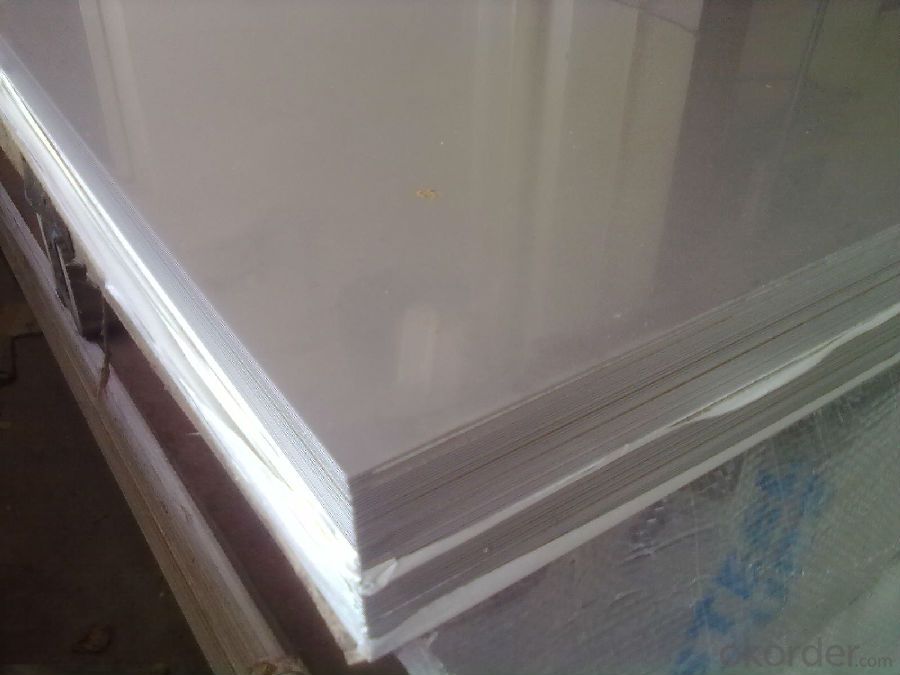



Sandard Seaworth Packing(wooden packing with water proof paper):

FAQ:
1. What are we supplying?
We are specialized in producing stainless steel coil, stainless steel (plate/sheet), and duplex stainless steel for a prelonged period. We are currently supplying grade of steel of 201/202,304/304L, 310S/309S/316L/316Ti/321, 410/420/430/443/444/409L, and 904L.
2. How Many years experience do we have?
We have been exported to more than 20 countries in the past 15 years.
3. How long do we usually reply your request?
We always reply our customer within 24 hours.
Our company adheres to the tenet of "survival by quality, build brand by reputation, win market by prices and innovate to develop", has developed international markets and the products are well sold in many countries as Singapore, Indonesia, South Korea, Dubai, Pakistan, Sri Lanka, Vietnam, Iran, Malaysia, Mexico, Chile, Brazil, Holland, Italy, Belgium, Russia, Moldova, Paraguay, Uruguay, Germany, Spain, USA etc. More than 40 countries.; commonly we have more than 500tons stainless steel materials in stock; so w can arrange the soonest delivery too; also we hope we will have chance to cooperate with your esteemed company!
- Q: Are stainless steel sheets suitable for laboratory equipment?
- Yes, stainless steel sheets are highly suitable for laboratory equipment. Stainless steel is known for its excellent corrosion resistance, making it ideal for use in laboratory settings where chemicals and other corrosive substances are frequently used. It is also easy to clean and maintain, which is crucial for maintaining a sterile environment in a laboratory. Furthermore, stainless steel is durable and can withstand high temperatures, making it suitable for a wide range of laboratory applications. Its strength and resistance to impact and wear ensure that laboratory equipment made from stainless steel can withstand rigorous use and last for a long time. Overall, stainless steel sheets offer a reliable and versatile material option for laboratory equipment.
- Q: What is the width of the carbon steel coil and the width of the stainless steel coil, one is 1250, and the other is 1219?
- A continuous rolling mill is put in billions of dollars, but this is the rolling mill, and there are many gold furnaces. But the technical content of carbon steel with stainless steel is different, our country in more than 10 years ago the ability of continuous rolling of stainless steel is not high, equipment are imported, the stainless steel mill is dominated by 1219-1300, but also the development of national wide stainless steel 1500-2050, but the price is expensive at least thousands of dollars a ton, after all put the equipment to recover the cost, and the number of business orders is not much, it is difficult to find a spot on the market. Carbon steel countries have developed for many years, technology and equipment are mature, so the market has 1250 as production standards.
- Q: Are stainless steel sheets suitable for chemical transport containers?
- Yes, stainless steel sheets are suitable for chemical transport containers. Stainless steel is highly resistant to corrosion, making it an ideal material for withstanding the potentially corrosive nature of chemicals. It also offers excellent strength and durability, ensuring the safe transportation of chemicals without compromising their integrity. Additionally, stainless steel is easy to clean and maintain, which is crucial for preventing cross-contamination during transportation.
- Q: What are the different surface finishes available for stainless steel sheets?
- Some of the different surface finishes available for stainless steel sheets include brushed, mirror, satin, and embossed finishes. These finishes can provide different aesthetic appearances and textures to suit various applications and design preferences.
- Q: What are the cost considerations when purchasing stainless steel sheets?
- The cost considerations when purchasing stainless steel sheets include the grade and quality of the stainless steel, the size and thickness of the sheets, any additional finishes or coatings, and the quantity being purchased. Additionally, factors such as transportation and delivery costs, as well as any applicable taxes or import duties, should also be taken into account.
- Q: Are stainless steel sheets resistant to UV radiation?
- Generally, stainless steel sheets have resistance to UV radiation. The composition of stainless steel consists mainly of iron, chromium, and other alloying elements, which contribute to its exceptional resistance to various types of corrosion, including UV radiation. The presence of chromium in stainless steel leads to the formation of a protective oxide layer on the surface, acting as a shield against UV rays and preventing oxidation or deterioration of the metal. Nevertheless, it is worth noting that continuous exposure to intense UV radiation can still result in some discoloration or fading of the stainless steel surface over time. To preserve the appearance and durability of stainless steel sheets used outdoors, it is advisable to regularly clean and apply appropriate treatments to protect the surface and ensure long-lasting performance.
- Q: What's the thinnest stainless steel plate in China?
- Performance analysis of stainless steel plate:High temperature oxidation resistance: stainless steel plate has high temperature oxidation resistance, but the oxidation rate will be affected by exposure environment and product form and other inherent factors.Physical properties: the total heat transfer coefficient of metals depends on other factors as well as the thermal conductivity of metals. In most cases, the heat dissipation coefficient of the film, the surface conditions of the rust and metal. Stainless steel keeps its surface neat, so its heat transfer is better than other metals with higher thermal conductivity.
- Q: Are stainless steel sheets resistant to scaling?
- Yes, stainless steel sheets are highly resistant to scaling. Due to their chromium content, they form a protective layer that prevents oxidation and scaling even at high temperatures.
- Q: What kind of screws do you choose for stainless steel plates?
- If it's a fixed plate, ordinary ones will doOf course, stainless steel screws are the best
- Q: Can stainless steel sheets be used in outdoor applications?
- Yes, stainless steel sheets can be used in outdoor applications. Stainless steel is highly resistant to corrosion and rust, making it an ideal material for outdoor use. It can withstand exposure to various weather conditions and is commonly used in outdoor structures, appliances, and decorative elements.
Send your message to us
Stainless Steel Sheet with 3mm Thickness
- Loading Port:
- Shanghai
- Payment Terms:
- TT or LC
- Min Order Qty:
- 2000 m.t
- Supply Capability:
- 5000000 m.t/month
OKorder Service Pledge
OKorder Financial Service
Similar products
Hot products
Hot Searches
Related keywords
